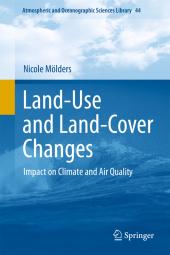 Neuerscheinungen 2013Stand: 2020-01-07 |
Schnellsuche
ISBN/Stichwort/Autor
|
Herderstraße 10
10625 Berlin
Tel.: 030 315 714 16
Fax 030 315 714 14
info@buchspektrum.de |

Nicole Mölders
Land-Use and Land-Cover Changes
Impact on Climate and Air Quality
2012. 2013. x, 190 S. 10 Tabellen. 235 mm
Verlag/Jahr: SPRINGER NETHERLANDS; SPRINGER 2013
ISBN: 9400736959 (9400736959)
Neue ISBN: 978-9400736955 (9789400736955)
Preis und Lieferzeit: Bitte klicken
This book offers a comprehensive review of current knowledge on how natural and anthropogenic land-use and cover changes affect weather, air quality and climate worldwide, and explains how these changes might trigger further land-use and land cover changes.
Wildfires, changing glaciers, deforestation, open-pit mining, increasing demands for food and bio-fuel production and the growth of megacities change our landscape. The book comprehensively reviews the current knowledge on how natural and anthropogenic land-use/cover changes affect weather, air quality and climate worldwide and explains how these changes may trigger further land-use/cover changes. It discusses how anthropogenic land-use/cover changes have affected local and regional climate and air quality since the settlement of America and the industrialisation. It addresses the topic how long-range transport of pollutants and dust of devasted areas as well as teleconnections may cause changes far away from the areas where the land-use/cover changes occurred, for which land-use/cover change may become an international issue similar to CO2. It also discusses relations to global change and future societal and scientific challenges related to land-use/cover changes.
1. Introduction.
1.1 Natural land-cover changes
1.2 Anthropogenic land-cover changes
1.3 Land-cover changes and weather and climate
1.4 References
2. Physical and chemical principles
2.1 Energy balance
2.1.1 Latent and sensible heat fluxes
2.1.2 Surface heterogeneity
2.2 Clouds and precipitation
2.3 Air chemistry
2.3.1 Emissions
2.3.2 Background chemistry
2.3.3 Polluted air
2.3.4 Aqueous chemistry
2.3.5 Gas-to-particle formation
2.3.6 Removal of gases and aerosols
2.4 Interaction between energy, water and trace gas cycle
2.5 References
3. Impact of land-cover and land-cover changes
3.1 Detection of land-cover changes
3.1.1 Land-cover maps
3.1.2 Remote sensing derived land-cover
3.1.3 Land-cover change detection
3.1.4 Role of land-cover data in land-cover related studies
3.2 Observations and major field experiments
3.3 Mechanisms
3.3.1 Changes of the surface fluxes
3.3.2 Secondary changes in response to land-cover change
3.3.3 Teleconnection
3.4 Scales
3.4.1 Inhomogeneity
3.4.2 Heterogeneity at various scales
3.4.3 Impact of heterogeneity
3.5 Land-cover change impacts
3.5.1 Deforestation and forest degradation
3.5.1.1 Tropical forests
3.5.1.2 Temperate forest
3.5.1.3 Boreal forest
3.5.1.4 Trace gas impacts
3.5.2 Conversion of native grasslands to cropland
3.5.2.1 Impact of irrigation
3.5.2.2 Trace gases
3.5.3 Droughts and desertification
3.5.4 Re-cultivation
3.5.4.1 Afforestation and reforestation
3.5.4.2 Drylands
3.5.5 Urbanization
3.5.5.1 Urban heat island effect
3.5.5.2 Urban impacts on clouds and precipitations
3.5.5.3 Other dynamical impacts of urbanization
3.5.5.4 Trace gas and aerosol release from cities
3.5.6 Water bodies
3.5.7 Interaction of land-cover change impacts
3.6 References
4. Future challenges
4.1 Future emission scenarios
4.2 Land-cover change impacts under future climate conditions
4.2.1 Biogeophysical feedbacks
4.2.1.1 Prescribed, fixed LCC
4.2.1.2 Gradually changing land-cover
4.2.2 Biogeochemical feedbacks
4.3 Air quality
4.4 Food and fuel production
4.4.1 Water availability
4.4.2 Soil degradation and land loss
4.4.3 Bio-fuel
4.5 Urbanization, urban areas and megacities
4.5.1 Urban heat island
4.5.2 Water management
4.5.3 Air quality
4.5.4 Urban planning and development
4.6 Detecting land-cover changes in observations
4.7 Changes of snow and ice
4.7.1 Snow-vegetation and permafrost-vegetation relation
4.7.2 Ice-vegetation relation
4.7.2.1 Sea-ice
4.7.2.2 Polynyas
4.7.2.3 Shelf-ice
4.8 References
5. Conclusions
5.1 Modeling and observations
5.2 Future assessment
5.3 References
Appendix: List of abbreviations
Index


